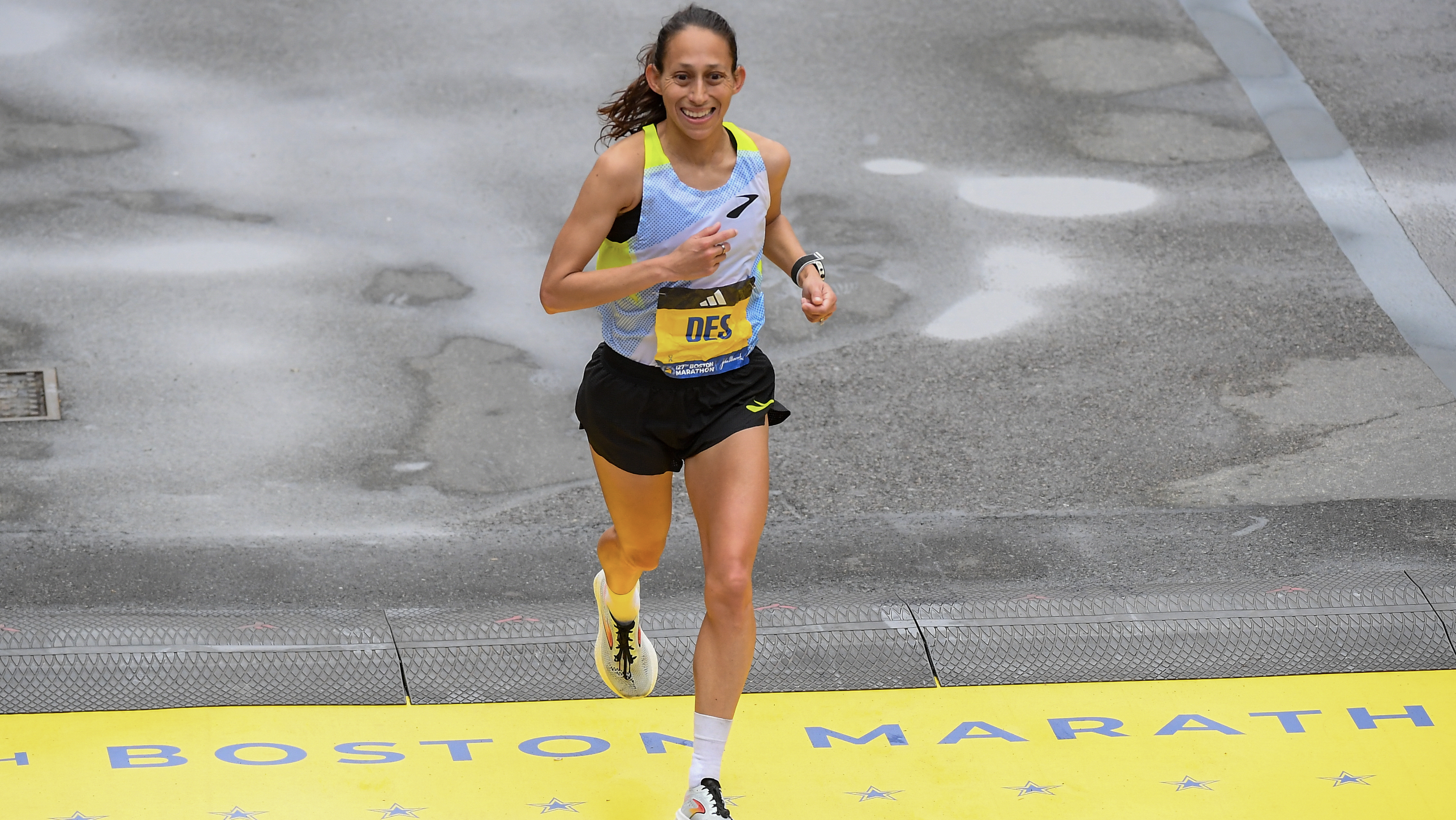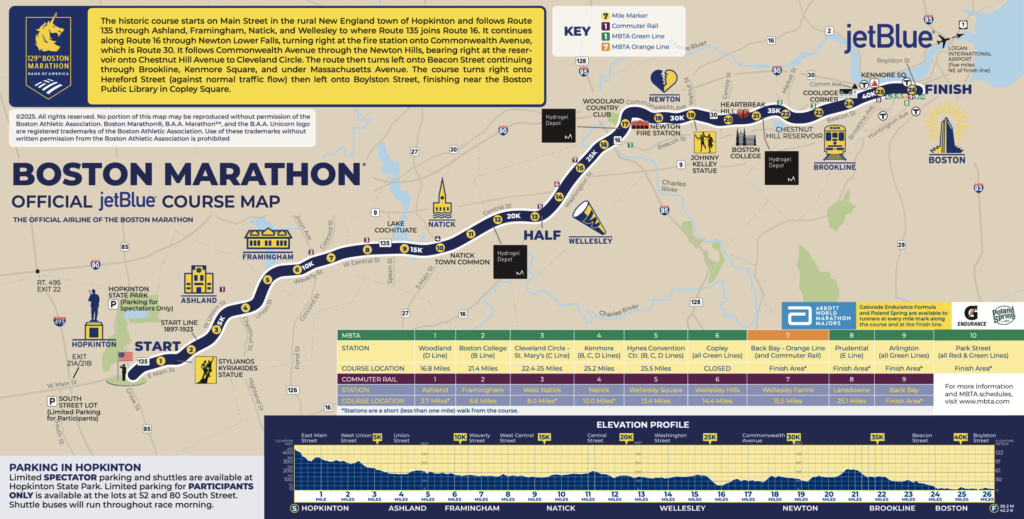
Having earned her legacy long ago, Des Linden will one day go down among the legends of American running. But for now, her steely focus is once again on racing in the Boston Marathon.
When she toes the starting line in Hopkinton, Massachusetts, on the morning of on April 21, it will be the 12th time the San Diego-born Michigan resident has raced Boston since her debut marathon in 2007. While no one will ever forget her chilly, rain-soaked victory in 2018, she’s also had four other top-five finishes in her career, including her electrifying second-place finish in 2011 (2:22:38) after her epic battle with Kenyans Sharon Cherop and Caroline Kilel over the final miles.
Although Linden is 41 and nine years removed from her seventh-place finish in the 2016 Olympic marathon in Rio de Janeiro, she is coming off a very strong year of racing in 2024 (11th in the U.S. Olympic Trials Marathon, 2:28:04, 16th in Boston, 2:27:58, 11th in the New York City Marathon, 2:29:32). As she prepares to run in Boston once again, she acknowledges that aging is real, but says she’s fit, focused, and ready to race as competitively as she can after a fast NYC Half Marathon (1:11:53) on March 16.
We caught up with Des Linden about her training, being back in Boston, how to race the marathon, and some of the fun things she’s working on with Kara Goucher. If you haven’t read her 2023 book, “Choosing to Run,” we’d highly recommend it!
Related: 8 Things To Know About the 2025 Boston Marathon
“I think that’s kind of the perk of winning there is you always get the invite back whenever you want to go. And just like the Masters golf tournament, it has sort of that ‘green jacket’ feel to it. Maybe I’m over inflating it, but it’s cool to go to a place where you feel embraced by the running community, but also by the local community. Obviously, at a certain point, I’ll turn into a different kind of runner, but if I’m still running fast and interested in covering those 26.2 miles. But I think I’ll always want to be in Boston in the spring on Patriots’ Day.”
“Yeah, and it’s actually a great place to be in. I feel I’m in a space where there’s nothing to lose and there’s nothing to prove. And so you can just go out there and run really free and have fun. I think it’s all relative, though. I look at the stuff I’m doing now and I’m like, ‘Wow, I haven’t really lost a step — this is pretty close to me at my best.’ And, obviously (shoe) technology has changed dramatically, so then you put yourself in the context of the actual competition, and you realize, ‘Well I have lost a step.’ But it’s still fun and it’s still fun to have the ability to be able to run this quick and use my body in this certain way. I know it’s ‘Use it or lose it’ right now, and I know as soon as I take my foot off the gas, it’s going to get pretty ugly pretty quick. So I feel like I’ve got to stay consistent, which has sort of been my M.O. throughout my career anyhow.”
“I think I’ve really tapped into the lifetime mileage. You don’t have to do quite as much. The volume doesn’t need to be as aggressive. There’s also the wisdom component of it, so it’s about managing both of those things and the idea that I know what I need to get out of a workout. And then there’s a point where you’re like, ‘Well, I’m just doing work for the sake of work’ versus ‘this work is helping me get better in this way.’ So knowing those things and when to push through and to be tough and then when to make a smart decision and know I’ve gotten everything I can out of that day and be able to turn it off a little bit early. That’s a fun thing to kind of manage, too. And I think that helps keep it really interesting.”
‘That’s a good question. I didn’t keep too close of an eye on it, but I bet it was like 105, 110 miles for my peak weeks. I was probably running 120, 125 miles a week from 2010 to 2016, so it’s definitely lower than that. But I think when you’ve got all of that mileage banked, and it feels right — and I feel like I’m staying healthy, which is kind of the main thing — then I know I’m ready.’ I think training’s gone really well. It’s been a really solid block. I haven’t had many hiccups, but I am a realist. Training looks really good on paper, but you never know what that means on race day, and it still comes down to how you race on race day.”
“I feel like it changes every year, because you get to spot, and you’re like, ‘Oh, that’s super cool. But I actually really enjoy the Newton Hills. I don’t know if they’re my favorite. Maybe the favorite spot is coming off the last one at Mile 21 and heading into Boston and knowing it’s pretty downhill and the crescendo of the crowd is rising. It just keeps building and building. I really like that part. But the Newton Hills themselves are the challenge that really gets you to Boston. That’s what you sign up for. That’s the moment you want. So I think I hate ’em when I’m in it, but then I’m also like, ‘This is literally why I signed up for this.’ So it’s kind of a fun challenge.”

“I think patience is the key in Boston, particularly that first 6 miles you can feel like it’s gonna be your day. You’re like, ‘Oh, everything feels so much easier!’ You’re tapered, the crowd’s out there, and the downhill is just pulling you down. But with the Newton Hills, they’ll bite you if you don’t take it easy early on. But I think with the hills themselves, every single one has a great recovery section on the other side of it. So when you’re in the hurt locker, running up it and thinking — ‘What am I doing? I should just back off a little bit. This is too hard. I can’t make it to the finish line from here if I stay at this effort level.’ — Just know once you hit the crest of that hill, you’re gonna have a long recovery before the next climb.”
Des Linden will be racing Boston in the soon-to-be-released Brooks Hyperion Elite 5, which is due out this summer. (We’ve highlighted the Brooks Hyperion Elite 4 PB in our roundup of 2025 super shoes for marathon running.)
“I think if you’re feeling good and have good legs after the hills, you have a good chance of running a very good marathon. I mean that’s just everything kind of coming together at once. You know, it’s the Boston course, but it’s also 26.2 miles, and you expect it to get hard there, but obviously all the mistakes or little things maybe you’d tweak later in Boston are kind of highlighted at that 21 point on. So you have to run smart early.”
“Well, I think it’s good energy. Sometimes you have the nerves and the taper and all of that and you sit around and you just overthink things. But it’s also a balancing act. In past years I’ve done a ton before the race and then got to the end and been like, ‘Oh, I finally get two and a half hours by myself where I just get to race. This is the best.’ But I think I’m managing it a little bit better this time, and I’m definitely more race-focused. There will be less activities for me this time, but it’s still great to be out and enjoy the city and the energy and get excited for Monday.”
“The podcast is just kind of us being honest and talking about running. We had some old lady gripes about the shoes in the early days and how it was impacting the sport, and I think someone on Twitter said, ‘You guys are just old and bitter.’ And I was, ‘Well, that would be an epic name for a podcast!’ We went in a different direction with the name, but the content is definitely just our off-the-cuff takes and it’s really unscripted and unedited. You know, there’s not a lot we’re pulling out, so you, you get to hear what we’re thinking pretty close to real time and on all the latest stuff. And I think that’s fun. I think it’s good to show more personality because athletes are more than just what they do between the curbs and on the track on race day.”
“Kara Goucher and I are organizing a track meet called, Save the 10,000 on May 3rd in Walnut, California, and that has been really exciting to put together. The goal is to just give athletes another opportunity to run the 10K on the track. It’s stressful and hard to be on the other side of it where you’re organizing an event, trying to get athletes to show up and fundraising and all these different things. But it’s been a great exercise, and I think we’re going to have an incredible stage for athletes to come and compete if they’re willing to come and compete.”
Save the 10,000 will provide 60 U.S. and international athletes (30 men, 30 women) a chance to chase qualifying standards for the 2025 USATF Outdoor Championships and the 2025 World Athletics Championships. The event is a Bronze Label race on the World Athletics Continental Tour and includes a $25,000 prize purse, including $5,000 for each winner.